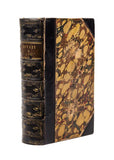Dealings with the Firm of Dombey and Son: Wholesale, Retail and for Exportation
Author: Charles John Huffam Dickens (1812–1870)
Year: 1848
Publisher: Bradbury and Evans
Place: London
Description:
xvi+624 pages with frontispiece and extra illustrated title and illustrations by H K Browne ("Phiz"). Octavo (8 3/4" x 6") bound in half navy calf over marbled boards. First edition in book form.
Dombey and Son is a novel by Charles Dickens, published in monthly parts from 1 October 1846 to 1 April 1848 and in one volume in 1848. Its full title is Dealings with the Firm of Dombey and Son: Wholesale, Retail and for Exportation.
Dickens started writing the book in Lausanne, Switzerland, before returning to England, via Paris, to complete it. Illustrations were provided by Hablot Knight Browne ('Phiz'). There is some evidence to suggest that Dombey and Son was inspired by the life of Christopher Huffam, Rigger to His Majesty's Navy, a gentleman and head of an established firm, Huffam & Son. Charles Dickens' father, John Dickens, at the time a clerk in the Navy Pay Office, asked the wealthy, well-connected Huffam to act as godfather to Charles. This same Huffam family appeared later in Charles Palliser's 1989 The Quincunx, an ambitious homage to the Dickensian novel form.
As with most of Dickens' work, a number of socially significant themes are to be found in this book. In particular the book deals with the then-prevalent common practice of arranged marriages for financial gain. Other themes to be detected within this work include child cruelty (particularly in Dombey's treatment of Florence), familial relationships, and as ever in Dickens, betrayal and deceit and the consequences thereof. Another strong central theme, which the critic George Gissing elaborates on in detail in his 1925 work The Immortal Dickens, is that of pride and arrogance, of which Paul Dombey senior is the extreme exemplification in Dickens' work.
Condition:
Text block cracked from backstrip, rubbing to boards, scattered foxing, ephemera indicating that the book belonged to one of Dicken's partners tipped to front end paper else a good to very good copy.











